Disclosure: Meeple Mountain received a free copy of this product in exchange for an honest, unbiased review. This review is not intended to be an endorsement.
Being bad is pretty good when you’re on top of the world. Money, fame, power – it’s all at your fingertips. Anything you want is there for the taking. Unfortunately for you, your days on top of the world are at an end. It turns out that King Taron wasn’t very fond of having his kingdom invaded. After a long and bloody conflict, your side lost. Now you’re doomed to live out the remainder of your life deep in the bowels of Kulbak Prison. Once you were on top of the world, now it’s quite the opposite.
But there’s hope that you might once again enjoy freedom and sunshine. Word has it that once a year, the king makes his rounds from prison to prison where he assesses the population and chooses one gang from each to fight for their freedom in the Colosseum. Comparing a slow, boring death in the depths of Kulbak Prison to the gamble of a quick death in the Colosseum (or freedom if you’re lucky), the best option seems obvious. It’s time to put together a gang!
Overview
Taking place in the Roll Player universe (much like the game Cartographers), Lockup: A Roll Player Tale (just Lockup from here on out) puts players in control of several crews vying for the position of toughest gang in Kulbak Prison. Using worker placement, the players take turns assigning their crew members to different areas of the prison as they work to gain resources, craft contraband items, and hire goons to their cause (all while trying to stay beneath the guards’s radar). Nobody said that a life of crime was an easy one. After six rounds, the player with the most reputation stars wins the game. Time waits for no man… or insectoid? So, you’d better get cracking!
If you’re only interested in hearing what I think about Lockup, feel free to skip ahead to the Thoughts section. If you’d like to know how the game is actually played, read on!
Know Your Place – A Tour of the Prison
Kulbak Prison is divided into 8 different areas. In the first phase of the game – the Roll Call phase – players take turns assigning their crew members (which have different strengths) to these various locations (some face up, some face down) in an effort to have the highest total value during the second phase – the Lights Out phase – wherein the different locations are resolved and their actions are performed. Key to understanding how Lockup works is knowing what benefits these provide. So let’s take a tour!
First up on our tour: the exercise yard, which sits in the center of the prison. The room is filled with the sounds of clinking metal and grunting. Most of the denizens here are busy lifting weights, but a few stand in the shadows of the portico silently staring at you. This isn’t a place for the faint-hearted or the weak-willed. This is where the bruisers hang out. If the body is a temple, these guys are the Taj Mahal. Here the players can gain power cubes, but only the player with the greatest or the second greatest strength will receive them. This strength-based resolution is true for every location in the game. The exercise yard is also how the first player marker gets moved around. Whoever comes out on top here will be the new first player.
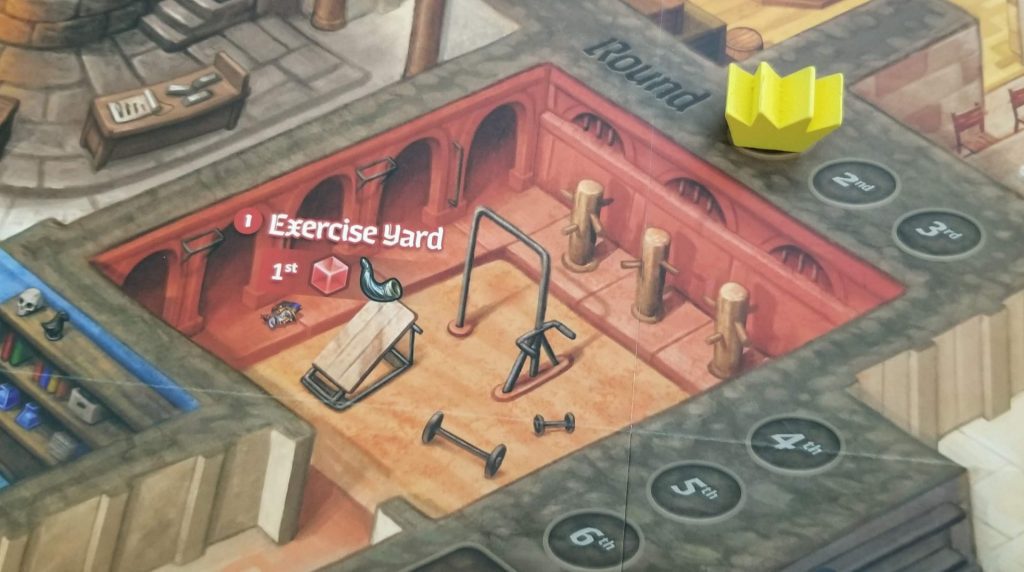
Now we walk down the stairs into the sewers. The smell here is almost overpowering. Water drips from the pipes (at least you hope it’s water) and everything is covered in a slimy, green film. It’s not a place that any sane individual would want to spend much of their time. This is where the players can obtain the green scrap cubes. The more strength a player can bring to bear here, the more cubes they will receive, but everyone is guaranteed at least one.

Climbing up the ladder from the sewer we push back the manhole cover, hoist ourselves up, and find ourselves in a sterile infirmary. Shelves with medical journals and colored bottles line the walls. A couple of beds sit off to the side at the ready should any patients find themselves in need of one. Everything here is clean and orderly, a far cry from the sewers we just climbed out of. This is where the players can obtain the blue potion cubes. However, unlike the sewers, only the players with the highest and second highest strength will receive any.

After taking a moment to cleanse ourselves of the sewer filth, we leave the infirmary and head upstairs into the smithy. The forge and furnace here fill the room with an oppressive heat. No sooner than you walk through the door, you break out into a sweat. How anyone can work in these conditions is beyond you, but the various workbenches scattered about the room serve as proof that someone does. In the smithy the players can obtain the grey iron cubes. Just like the infirmary, only the players with the first and second highest strength will get any.
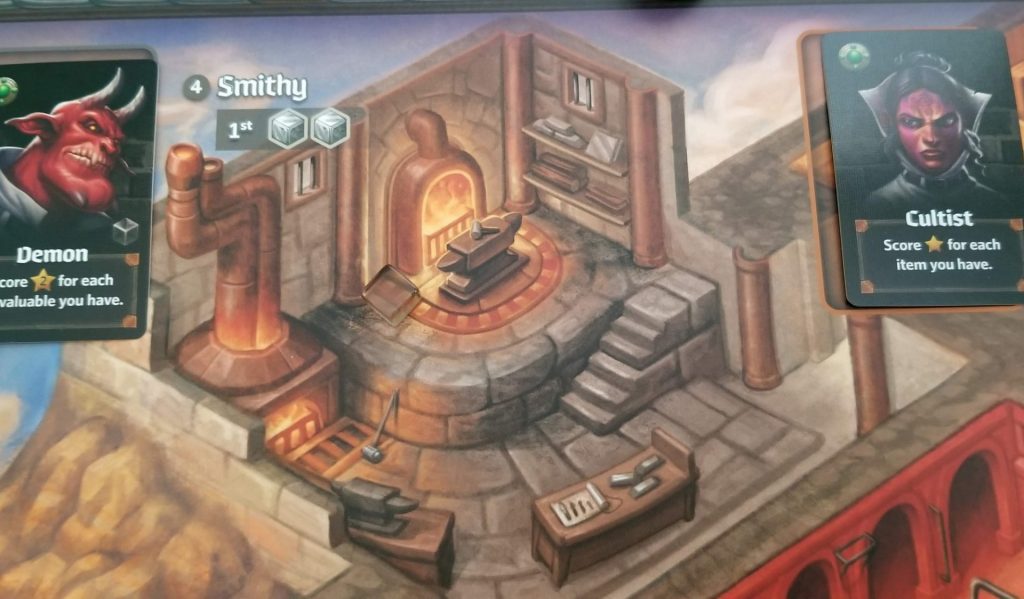
Moving from the smithy (praise the gods because that place was HOT!) we travel down a short hallway into the commissary. It’s not a very remarkable room. On one side of the partition that lines the room are places for prisoners to stand and interact with the clerks on the other side. If you’ve got the cash, the clerks will give you pretty much anything you want. The player with the highest strength here can take any single resource cube (green, blue, or grey) of their choice for free. Everyone else is stuck having to exchange resources for different ones.
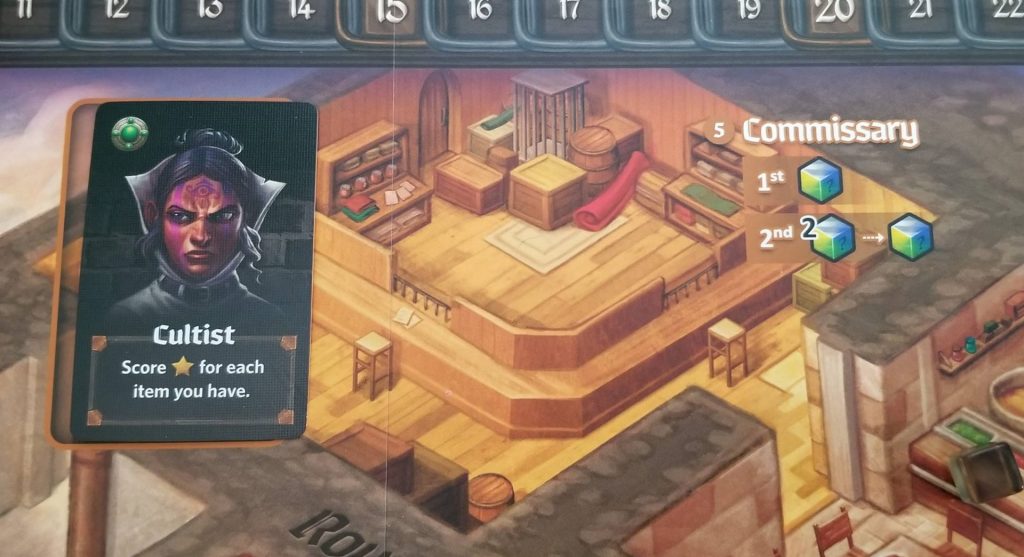
The commissary is connected by a doorway to the chow hall. The chow hall has only one volume – loud – and it reeks of old onions. Part of that is due to the body stench of the patrons, but a larger part is because of the “food” that they serve here. My advice: if you’ve got cash in your account, you’re better off getting something from the commissary. You’ll discover in the chow hall that some of your fellow prisoners aren’t loyal to any specific crew, but for the right price, they’ll gladly pledge their loyalty to yours. Here players will have the opportunity to recruit the face up Goons to their cause. These Goons provide the players with reputation stars and some provide other benefits when they are acquired as well (free resource cubes, for instance).
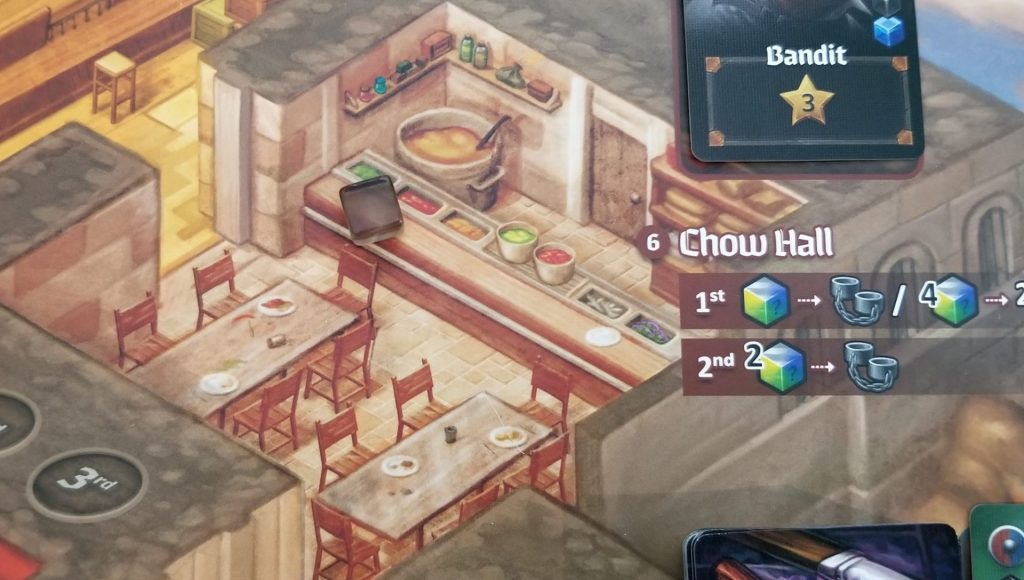
If you thought that smelled bad, follow me down this hallway to the cell block. When I look around me, I don’t see the iron bars and the stone walls anymore. I see a thriving community bustling with activity. Over there is Big Tony’s house. Sammy the Knife lives across the way there. And here we have my place. This is where it all comes together. In the cell block the players will have the opportunity to use their collected resources to craft the face up items. The Item card display does not refill until the end of the round, so it behooves any player wanting to go to this spot to try to be first place in total strength. Finders keepers. Losers… well, you know. Some of these items provide immediate benefits when they are produced (discarding a suspicion cube, for instance) and others are just worth straight up reputation at the end of the game.

And down this short stairwell is the library. It’s a weird place. It’s where all the losers from all the other locations go so that they can feel like winners. Theoretically we’re supposed to use the knowledge stored in these tomes to turn ourselves into better versions of ourselves, but I find that knowledge is power. Leveraged correctly it can accomplish great things. Here the players will collect tomes from the Tome deck. These will provide useful, one time benefits, like the ability to move already placed crew members around or to gain free resources.

And that concludes our tour. Welcome to Kulbak Prison. We hope you’ll enjoy your stay.
In the Clink – the Setup
The game board for Lockup depicts Kulbak Prison, divided into its 8 different sections: the exercise yard, the sewers, the infirmary, the smithy, the commissary, the chow hall, the cell block, and the library. With the exception of the exercise yard, cell block, and library each of these locations has a spot for a Goon card. The Goon card deck is shuffled and one Goon is placed face up into each of these spots. The remaining Goon cards are placed close by in a face down deck. If any of the face up Goons depicts a suspicion cube, then a suspicion cube is placed onto the location where the Goon was placed. The remaining suspicion cubes are placed into the Suspicion area of the game board.
The library is where the Tome cards live.These cards are shuffled and placed face down onto their designated spot. Just above the library is the cell block where the Item cards are placed. The Item card deck is shuffled and placed face down onto the “Item Deck” location and then a number of cards (based on player count) are flipped face up into the Item card spots.
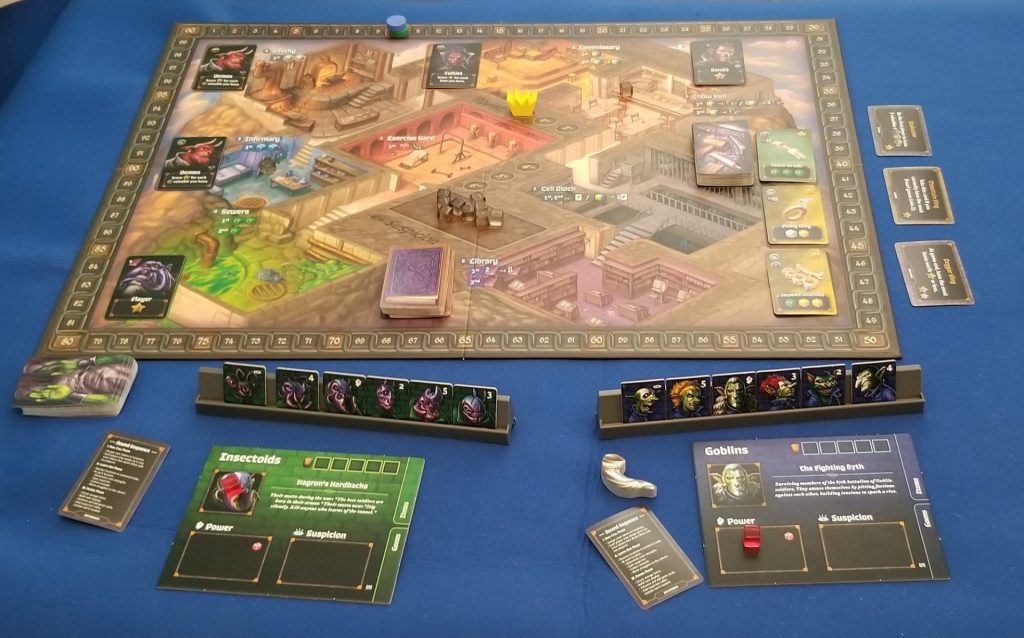
Next, each player chooses a crew that they will be controlling. They receive the Holding Cell, the matching crew tokens (which are placed into the Holding Cell), and the appropriate Crew Board which are placed in front of them. The players also receive a Reputation Marker, which is placed on the 10 on the score track, and a single power cube, which is placed into the Power area of their Crew Board. The remaining power cubes (along with all of the resource cubes) are kept off to the side in a general supply.
Lastly, three Goal cards are selected from the Goal card deck (one of each type: leader, instant, and end game) and placed off to the side and then the round marker is placed onto the 1st position of the round tracker. The unused Goal cards are returned to the box. Once a start player is chosen they are given the first player marker and you are ready to begin.
Doing Time – The Game Phases
Lockup is played over a total of 6 rounds and these rounds are divided into 3 distinct phases: Roll Call, Lights Out, and Patrol. In the Roll Call phase, players take turns assigning one or more of their crew tokens to a single location. It’s up to the player whether or not the tokens will be assigned to the location face up or face down. However, there can only ever be up to two assigned face down across the board per player per round. Once a player has assigned crew tokens to a location, they cannot assign any other token there on future turns. Once each player has assigned all of the crew tokens that they wish to assign, the Lights Out phase begins.

In the Lights Out phase, each location will be resolved in order beginning with the exercise yard and following the path all the way to the library. In each location, the players will compare the total strength they have brought to bear there, by adding up the numeric values printed on the tokens, and the person with the highest strength will collect the first place reward, with the second place award going to the player with the second highest score, etc. Any players that did not collect a reward from a non-library location will then move all of their crew tokens to the library instead.
While most of the crew tokens have a specific numeric value, there are two that do not. The first is the Enforcer whose power is equal to the number of power cubes on its controller’s Crew Board. The second is the Lookout, which allows its controller to avoid suspicion:
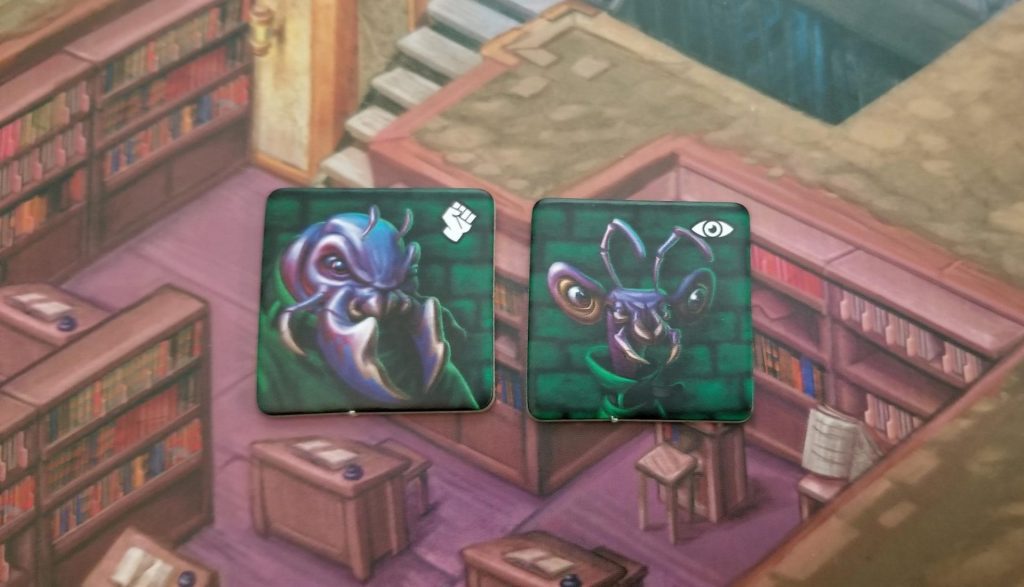
When awarding first place, second place, etc. to the players that have brought strength to bear at a location, the person in first place will take any suspicion cubes that are present in that location and add them to the Suspicion area of their Crew Board… that is unless their Lookout is present at that location. In that case, the suspicion cube is given to the second place player unless they also sent their Lookout to this location in which case… well, you get the picture. It could wind up that the suspicion cube just remains unclaimed at the location.
Once each location has been processed the Patrol phase begins. The players will discard down to the resource limits printed on their Crew Boards, refill the Item card display, and advance the Goon cards. If there happens to be a Goon card present in the rightmost spot, it is removed from the game board and placed into a discard pile. Finally, if any of the visible Goons feature the image of a suspicion cube, then a suspicion cube is added to their location. If there aren’t any cubes left to add, then a raid is triggered.

When a raid is triggered, the players count up the suspicion cubes on their Crew Boards. The player with the most loses 8 reputation. The player with the second most loses 4. After the reputation scores have been adjusted, the suspicion cubes are moved from the Crew Boards to the Suspicion area of the game board and players will continue populating the remaining locations with suspicion cubes where required.
Play continues in this fashion until the end of the 6th round at which point one final raid is triggered. Then the players tally up their scores and the person with the most reputation stars wins. Reputation stars are gained from collected Goon cards, Item cards, and fulfilled Goal cards. These come in three different types: leader goals (which are awarded to the person or persons that meet the goal condition the best), instant goals (which are awarded to the very first person to meet the goal condition), and end game goals (which are awarded to everyone that meets the goal condition).
Thoughts
Lockup is one of those very few games that I have nothing negative to say about. From the packaging to the components to the rule book to the actual game play, everything about this game is spot on. Stanislav Kordonskiy has created a pretty magnificent game. At first I was amazed that this first time designer had managed to catch lightning in a bottle on his first try and then I found out that Lockup actually isn’t his first stroll around the prison yard. For me, Stanislav Kordonskiy is to game design what Luis Guzman is to acting. His is one of those names that you’ve seen all over the place but never realized it. It wasn’t until I looked him up on BoardGameGeek that I discovered that Mr. Kordonskiy is also the mind behind Rurik: Dawn of Kiev and Dice Hospital (both of which were very well received by the Meeple Mountain staff). Knowing that, it comes as no surprise that Lockup is as good as it is.
What makes Lockup great goes beyond just the game’s pedigree, though. One of the elements that I particularly enjoy about the game is that it takes place inside of the Roll Player universe – a universe which didn’t actually exist at Roll Player’s initial inception. When Roll Player was released into the world back in 2016, there was no mention of the Kingdom of Nalos or the Dragul. I’ve had the great pleasure of watching that world develop over the years in various spin-offs and expansions, culminating in 2020’s future release of Roll Player Adventures. Playing Lockup makes me feel like I’m one of the shady denizens of Kulbak Prison trying to put together the toughest gang. While the story in Cartographers (the other Roll Player Tale game) felt like it was kind of tacked on, the story here just works. It really helps to sell the action taking place in the game.
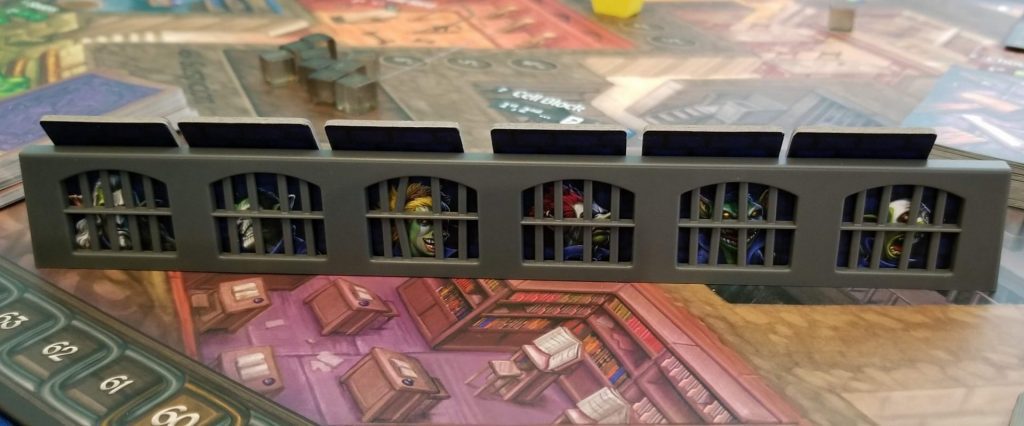
Now, there are thousands of worker placement games out there and the concept of sending a guy to a space to collect a thing and then using that to make a different thing that’s worth victory points is nothing new. Lockup hasn’t reinvented the wheel in that regard. True to form, the players are sending guys to different places to collect things to turn into other things for points. If that’s all there was to it, I could think of a bunch of other games that do those specific things much better. What really makes Lockup sing isn’t that you’re just placing workers, it’s that you’re placing workers of different values. It’s that value-driven area control component that changes everything.
I love the way that Lockup constantly keeps you guessing about what you think your opponents are likely to do so that you can make your own moves accordingly. The tricky part is that they’re all doing the exact same thing, so everyone is constantly plotting and planning using limited information. “Did my opponent just put two face down tokens in the infirmary with the intention of winning it or with the intention of trying to fake me out to make me think they want to win it? I really need those blue cubes. Should I send my biggest guys there? Maybe I should try for second place. At least I’ll get something. But what if…” and on and on it goes. You throw down some crew tokens and then cross your fingers. It’s a deceptively clever game that always has you second guessing everything.
In Lockup, even while you’re planning for success, you’re also planning for failure. Since any losing crew tokens are sent to the library, it might actually be in your best interest to intentionally lose at some locations. In fact, if you want to get your mitts on those game-changing Tome cards, you’re going to have to. I’m sure there are other games out there that put you in a position of intentionally losing in order to win something else, but if there are, I can’t think of any. It’s a counter-intuitive concept, yet in Lockup, it works so well.

I know I said earlier that I really can’t think of anything negative to say but if I were hard pressed to come up with something it would be that the Roll Call phase can get quite lengthy at higher player counts because of all of the second and third guessing. However, even though this phase can be lengthy, it doesn’t FEEL lengthy because there’s never a point in Lockup where you’re disengaged. Regardless of whose turn it is you’ll find yourself plotting out your next move and paying rapt attention to theirs because everything that anyone does in this game has some effect on everyone else whether it be beneficial or deleterious. So be aware that the game length listed on the box assumes that everyone playing is making lightning fast, uninspired decisions. Your mileage may vary.
Yep. I love Lockup. It’s just a super fun, clever game. The artwork is fantastic, the game play is stellar, the components are high quality… what more could you ask for? Lockup is a game that I’m always up for playing and one that I am proud to have on my shelf. I can’t wait for Roll Player Adventures and I certainly hope that Kulbak Prison will make an appearance because I have thoroughly enjoyed the time that I have spent there.


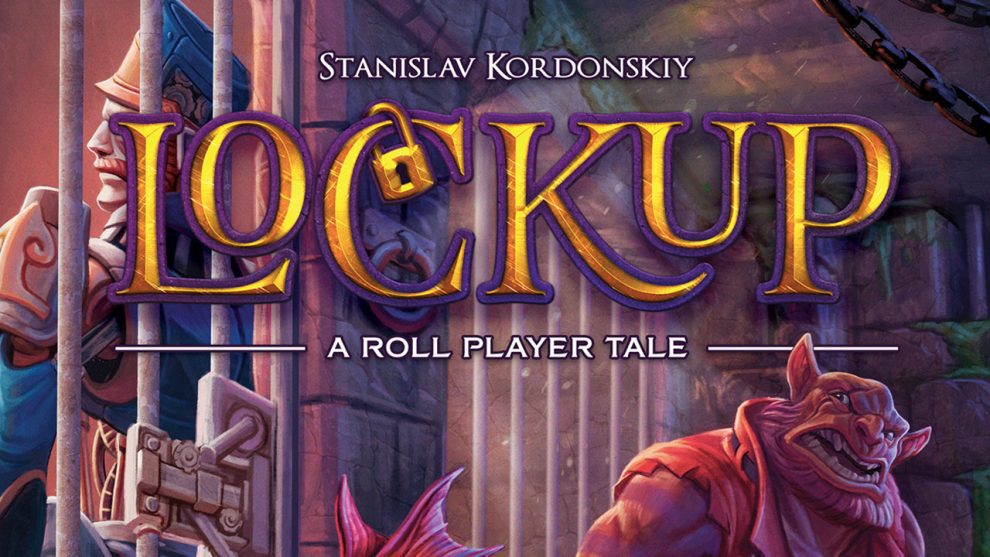
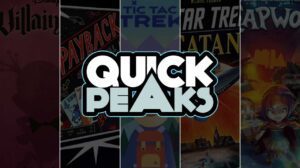







Add Comment